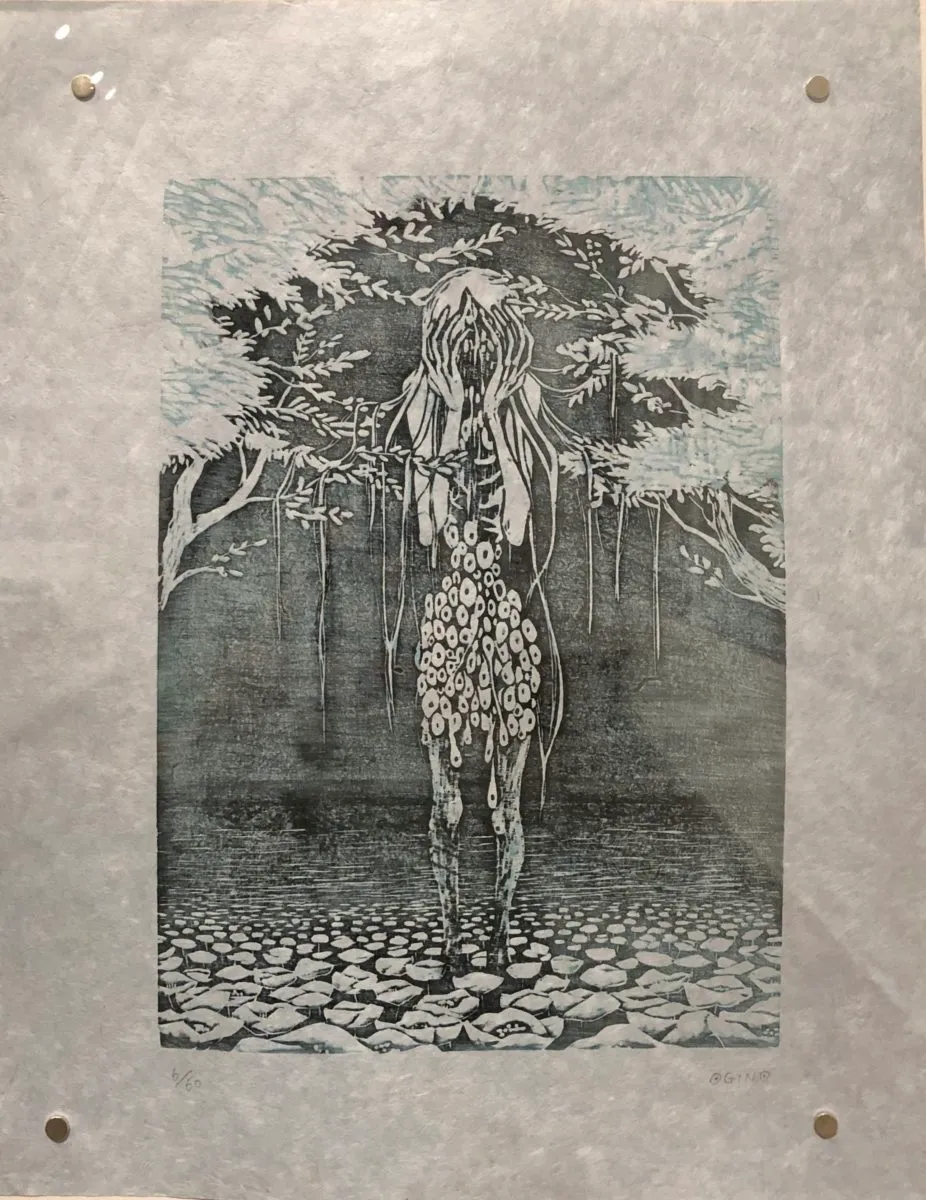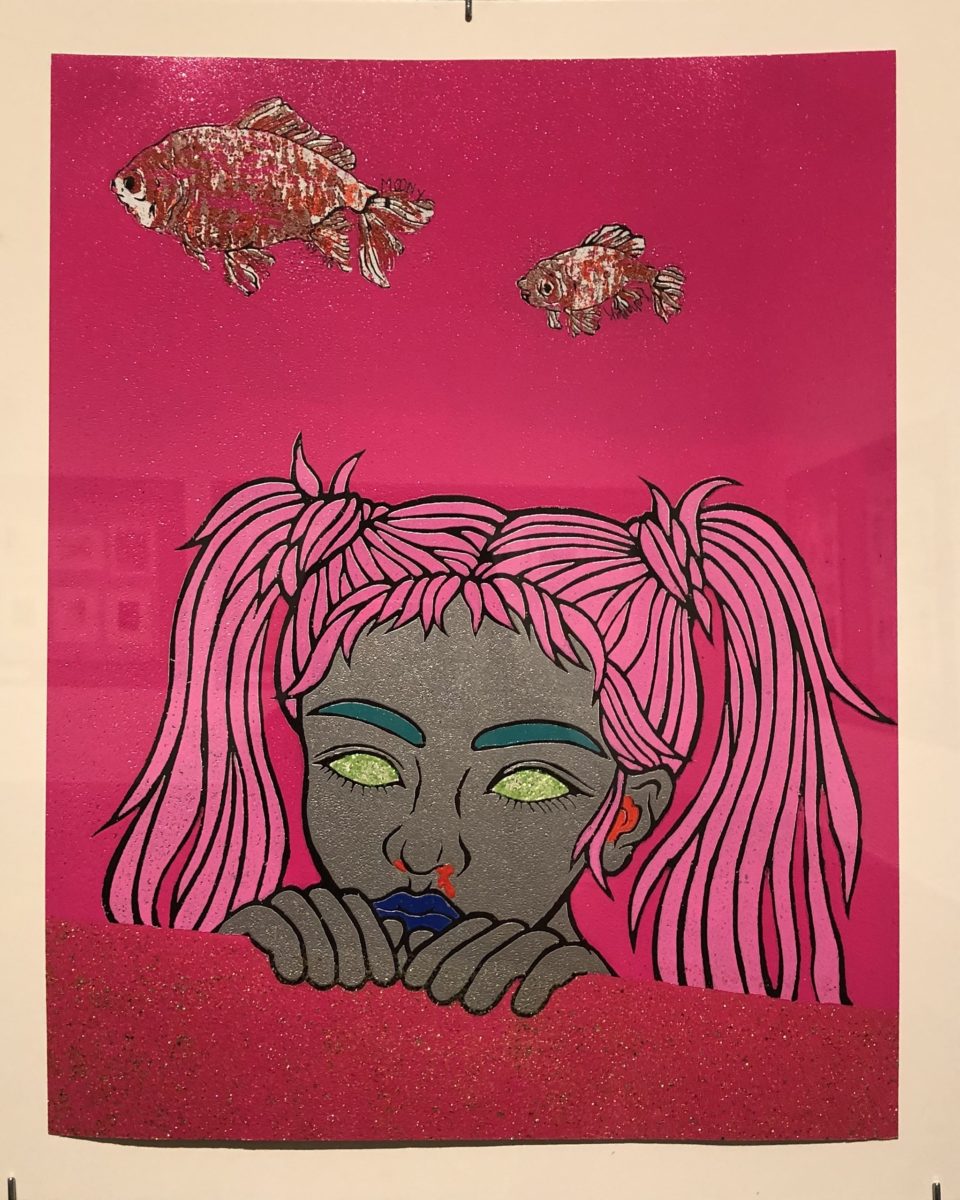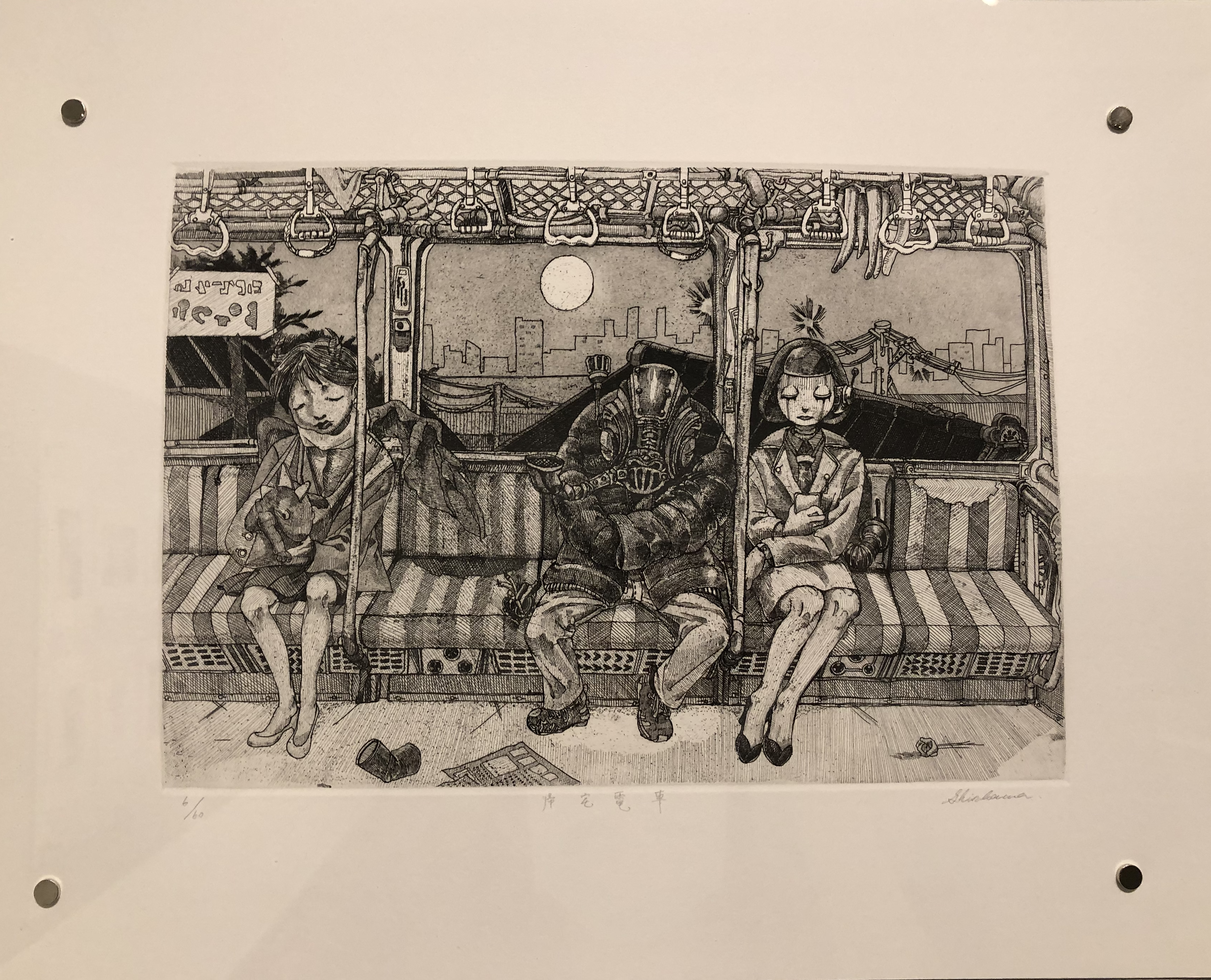A flurry of green descends from a gradient of burnt orange melting into yellow, like leaves swirling down from a November sky. “Full of Autumnal Scent” is on view from Nov. 1 to Dec. 3 at the Stanford Art Gallery, and the exhibition showcases ten years of prints made by undergraduate and graduate students from Tama Art University, one of Japan’s leading art schools.
Every year since 2009, Tama Art University has sent a box of its students’ prints to Stanford. This connection was established by the friendship between Reiko Oshima, who has served as a print show director and president for the College Women’s Association of Japan (CWAJ), and Sally Porter, who was previously a CWAJ affiliate and now works as a docent at Cantor Arts Center. The exhibition features a diverse selection of works ranging in style from hyper-real to completely abstract, all executed with extraordinary quality and incredible detail. Despite their differences, the prints all unsettle reality and question the premises of the world we live in.
Many of the pieces depict fantastical worlds by taking details from our everyday lives and altering them. In “Electric Train,” Saori Sinkawa creates a world composed of cold and metallic electronic gadgets that still retains a deep sense of humanity. Behind a row of hanging handlebars, a cluster of tentacle-like cords intrudes into a train car, representing the presence of the otherworldly within seemingly normal settings. Sitting next to a character with an industrial contraption as its head, a girl pensively looks at her phone. Upon closer inspection, we realize that she is a robot too — the vertical streaks running down her face suggest that she is metallic. However, these streaks also resemble streaming tears that unexpectedly humanize her. Sinkawa’s attention to verticality, from the dangling tentacles to the handrails to the stripes on the seats, gives the print a sense of heaviness, as if everything within it is pulled down by gravity. A sleepy tranquility permeates the train car and draws us into a somnambulist’s world.
Accompanying this transformation of familiar settings into a fantastical realm is a fascination with metamorphosis. In Kiyoko Hagino’s “Conference 5,” a girl’s flesh melts into nondescript droplets that drip down her body and then blossom at the forest floor. Standing in the cocoon of two conjoined trees, the girl morphs into a plant-like life form. Similarly, in Hitomi Yoshida’s “Flow,” a human body merges with a mass of corals and shells. By depicting the body’s decomposition into a pattern of abstract shapes or absorption into its natural surroundings, the artists ponder the breakdown of the body’s boundaries. Its dissolution into meaningless shapes shows that it is nothing more than mere ink, dripping down or darting across the page. These prints play out the process of meaning coming into being within representational art, while evoking the constant threat of meaning disintegrating. The printmakers demonstrate an awareness of their own medium — the solidity of wood and metal molds melts into ink, and that ink in turn forms embodied entities and recreates material texture.

Kiyoko Hagino, “Conference 5,” 2009, woodcut (Photo: BETTY HE/The Stanford Daily)

Hitomi Yoshida, “Flow,” 2013, woodcut (Photo: BETTY HE/The Stanford Daily)
An unsettling effect of metamorphosis is also apparent in the copious renderings of faces in the exhibition. In Kentaro Takano’s “Scream,” a face wrinkled in anguish and agony comes into being through fevered squiggles. The frantic energy held within the print’s intersecting lines mirror the expression of its subject’s face. Saki Kitamura’s “Grasslands and Galaxy II” depicts a girl crouching on what could be a windowsill, her glittering green eyes desiring to escape into an alternate reality. These faces unabashedly express familiar emotions and recognizable yearning, adding to their strangeness when depicted in near-monstrous forms.

Kentaro Takano, “Scream,” 2018, etching (Photo: BETTY HE/The Stanford Daily)

Saki Kitamura, “Grasslands and Galaxy II,” 2013, woodcut (Photo: BETTY HE/The Stanford Daily)
These prints are at once foreign and familiar, touching upon common human experiences while reminding us that we don’t fully understand the cultural background from which they emerge. When Tama Art University sent these prints to Stanford, they provided no accompanying context for the artists’ creations, leaving many questions unanswered: what was the artists’ education like? What artistic and cultural influences were the artists under? What socio-political realities were they living in?
Akiha Yamagami’s lithograph “It may not last all through my life” depicts an amorphous scene tearing through paper and opening into a tangle of contorted bodies. It recalls the deformed bodies of damned souls struggling to cling to the clouds of Heaven in Michelangelo’s “Last Judgment.” When I make this comparison, I interpret the print under the framework of western European art history, which potentially obscures other significance that the print can have. However, in my education, no other framework has been available for evaluating these artworks. Many of us don’t know the culture they come from, so we can only guess and leave space for mystery in our interpretations. These prints open us into an unfamiliar world; my interpretation of the painting through the lens of Michelangelo is my way to tame the terror of the unknown that the print aroused in me, not an objective one. Through depicting the bodies with detailed texture, Yamagami renders this strange new world as real as our own, ultimately forcing us to confront its unsettling sublimity.
Curators Kathryn Kain, Katharine Keller and Gabriel Harrison preserve that sense of mystery with a touch of humor when displaying these prints. They’ve arranged the prints in chronological order from 2009 to 2019, with prints from the same year being grouped together. A missing 2010 board disrupts this timeline. Harrison told The Daily that this is because the 2010 prints were put in the 2009 and 2011 boxes that Tama Art University sent to Stanford. Rather than asking Tama Art University to elucidate upon this choice, the curators decided to leave it as a mystery for viewers. Another intriguing detail within the exhibition is that Tama Art University only sent Stanford the sixth editions of each print. Harrison mused, “what happens if there was a mistake in number six? Does that student get excluded from the shipment they send to Stanford?” These anomalies let viewers in on the curators’ thought processes and prompt them to chuckle. A pervading sense of humor both within the prints and in the curation reminds us of the human connections that birthed this exhibition.
Ayaka Nakamura, “Untitled,” 2012, hayter
Yuri Sakurada, “Grow, droop,” 2012, etching, aquatint, drypoint
Ikumi Okada, “Happen to meet, overnight hike,” 2012, woodcut
Mariko Sarashina, “Myself,” 2012, woodcut
Akie Suzuki, “Brier,” 2012, etching
Nozomi Hombu, “ONNa No ko,” 2012, woodcut
(Photo: BETTY HE/The Stanford Daily)
Although it is easy to overlook the framing structures around the prints, they are meticulously designed to help connect the artwork yet allow each piece to maintain its individuality. In order to allow viewers to step as close to the prints as possible without touching them, the curators installed a piece of plexi-glass fixed with metallic gray screws in front of the prints. Since the prints are delicate and cannot be punctured or framed, the curators secured them to the backboard with magnets that look like smaller versions of the screws. A mirroring between the screws and the magnets allows the gray borders to frame the set of six 2012 prints as one artwork, while the white border demarcates the boundaries of each piece. “ONNa No ko” enlarges the face in “Myself,” while specks of pink littering the background of “Myself” in turn echo the hot pink florals in “Untitled.” Responding to technical limitations, the curators created fluid means of separation between the prints that lend to a more complex viewing experience.
In both the prints themselves and the curation of the exhibition, the bizarre intrudes into the ordinary. There are strands for interpretation to hold onto, but ultimately, much is unknown to both the curators and viewers about these prints. Through absorbing us into their fantastical realities, these prints push us to extend our realms of possibility into foreign terrain.
“Full of Autumnal Scent, 10 years of graduate printmaking from the Tama Art University, Tokyo, Japan” is on view at the Stanford Art Gallery from Nov. 1 to Dec. 3, 2021. The Stanford Art Gallery is open Monday – Friday from 11 a.m. to 5 p.m.
Editor’s Note: This article is a review and includes subjective opinions, thoughts and critiques.
This article has been edited to reflect that the institution in question is “Tama Art University” not “Tama University.” The Daily regrets this error.
